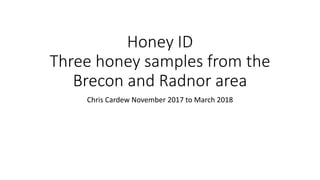Honey Identification in Brecon and Radnor
- 1. Honey ID Three honey samples from the Brecon and Radnor area Chris Cardew November 2017 to March 2018
- 2. Honey No.1 ŌĆó This honey is from the general Talgarth, Bronllys area. ŌĆó The overriding pollen is from Apple, with much also from Hawthorn. There are also pollen grains from several other plants including; oak, daffodil, white clover, dandelion, redshank, broad bean, oil seed rape and borage. There are several smaller pollen grains which are very difficult to identify, but I would guess that they might come from trees; willow and birch.
- 3. The triangular pollen grain is APPLE between 37- 39um in width. The middle grain of the lower three is OIL SEED RAPE The grain top right is around 22um, I think this might be HAZEL, but not the most striking example
- 4. The large round grain is most likely REDSHANK (36um). A weed of cultivation.
- 5. The lower darker square looking pollen grain is DANDELION (30um although the books vary on size up to 40um). The upper triangular grain looks like RASPBERRY or MOUNTAIN ASH (28-30um)
- 6. The large circular grain (38um) not sure what this is but it may be a grass.
- 7. The long cylindrical pollen grain is that of BROADBEAN (49um). The books state that broadbean is around 42um, but there is some variation. Broadbean is very similar in shape to Hogweed, but hogweed has slight inversions half way along the grain. The circular grain with three distinct white marks looks like WOOD SORREL or MEADOWSWEET(18um)
- 8. The round pollen grain with 10 furrows is that of BORAGE (33um)
- 9. These pear shaped grains are those of the PEAR (39um) Sawyer Pollen ID p68.
- 10. The half moon shape pollen grain is that of DAFFODIL (55um). Bluebell is similar but smaller (42um)
- 11. APPLE (37-39um) to the right and HAWTHORN (37um) to the left. What I really liked here was the image of a creature in the main part of the photo.
- 12. APPLE lower left and HAWTHORN mid right. In between these two is an oval pollen grain with spiky edges about 28um in width. This could by a PRIVET grain. Interesting that a small ŌĆśbranchŌĆÖ has been captured being just over 1mm in length
- 13. Honey No 4 ŌĆó This honey comes from the Beulah Newbridge area. ŌĆó It includes pollen grains from Lime, Maize, Field Thistle, Cow Parsley, Dandelion, Bluebell, Gorse, Blackthorn and Hazel among others
- 14. A plain oval shaped pollen grain of around 55um in width is probably that of a cereal such as MAIZE
- 15. The pollen grain below is that of LIME (28um)
- 16. FIELD THISTLE pollen grain (40um)
- 17. The long oval pollen grain is COW PARSLEY(30UM). The central grain is GORSE (30um) The larger grain at the bottom has the shape of clover but is too big at 40um. I feel that this may be VIRGINIA CREEPER.
- 18. The main pollen grain is that of DANDELION (32um). The grain to the immediate top right of it looks like HAZEL (20um)
- 19. this may be BLACKTHORN pollen grain 37um because of the little dimples in the three corners
- 20. This pollen grain might be that of GORSE 25um
- 21. I think this may be the half moon shape of the BLUEBELL pollen grain 40um
- 26. Honey No 6 ŌĆó This honey is from the Painscastle area ŌĆó Predominantly heather honey with both ling and bell heather, also common mallow, field thistle, harebell, bramble, white clover and meadow sweet or wood sorrel.
- 27. This large round spiky pollen grain is from COMMON MALLOW (110um) Attached to it are heather and other smaller grains
- 28. Several grains of LING HEATHER and the smaller round grains are MEADOWSWEET or WOOD SORREL
- 29. The triangular grain is pollen is from BRAMBLE or BLACKBERRY (32um)
- 30. The spiky round grain to the left is that of a FIELD THISTLE (40um). The small triangular grain below WHITE CLOVER (20um)
- 31. The three smaller round grains each with three equidistant white markings look like MEADOWSWEET or WOOD SORREL (18um). (Dorothy Hodges has white charlock looking identical to these but I am not aware of any such crops in recent years). The larger round pollen grain is more difficult to determine. The closest I can find is HAREBELL (40um) The grain lowest left is LING HEATHER
- 32. A mixture of LING (36um)and BELL HEATHER (42um)

































